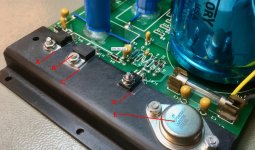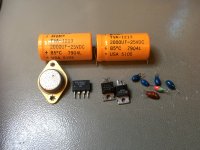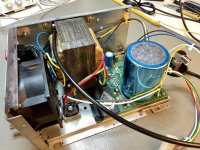The Byte Attic
New Member
- Joined
- Aug 1, 2024
- Messages
- 6
Hi all,
I've recently acquired a strange hybrid: a SOL-20 case, with PSU and keyboard, and a single-card computer in the S-100 expansion; no SOL motherboard. The PSU struck me as odd. Here's a photo after restoration (yes, I know the radial caps replacing the original axial ones look unauthentic, but this is a fully linearly-regulated PSU that produces ridiculous amounts of heat, so I chose 135C-rated capacitors for longevity, and they are only available in radial packaging):
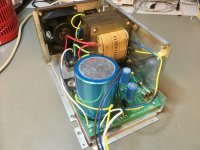
As you can see, unlike the regular SOL-20 PSU, the transformer is mounted sideways, while the single bulk capacitor is mounted vertically. Also unlike the regular PSU, the 5V rail is linearly regulated with an LM323K:
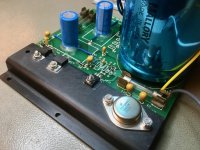
I believe this was originally purchased as a kit, as the crowbar circuit was unpopulated (I populated it in the photo above) and the soldering job, although adequate, wasn't uniform.
Do any of you know the history of this particular revision? It is clearly an earlier iteration of the SOL-20 PSU we are all used to. Was this sold as a kit accompanying the SOL-10 perhaps? I can't find any documentation or references online. This isn't really a problem, as the circuit is extremely simple and easy to even guess from just looking at the components, let alone reverse engineer. But I just can't trace its place in the timeline.
I am posting it here in the hope of not only learning something from you, but also finding out if there is any historical significance to this beyond the SOL-20's own significance. This will go to a museum anyway, but if you guys know that this is a unique survivor, or something of that kind, I'd be happy to make all technical details available to the community. I, of course, kept all the original parts.
I've recently acquired a strange hybrid: a SOL-20 case, with PSU and keyboard, and a single-card computer in the S-100 expansion; no SOL motherboard. The PSU struck me as odd. Here's a photo after restoration (yes, I know the radial caps replacing the original axial ones look unauthentic, but this is a fully linearly-regulated PSU that produces ridiculous amounts of heat, so I chose 135C-rated capacitors for longevity, and they are only available in radial packaging):

As you can see, unlike the regular SOL-20 PSU, the transformer is mounted sideways, while the single bulk capacitor is mounted vertically. Also unlike the regular PSU, the 5V rail is linearly regulated with an LM323K:

I believe this was originally purchased as a kit, as the crowbar circuit was unpopulated (I populated it in the photo above) and the soldering job, although adequate, wasn't uniform.
Do any of you know the history of this particular revision? It is clearly an earlier iteration of the SOL-20 PSU we are all used to. Was this sold as a kit accompanying the SOL-10 perhaps? I can't find any documentation or references online. This isn't really a problem, as the circuit is extremely simple and easy to even guess from just looking at the components, let alone reverse engineer. But I just can't trace its place in the timeline.
I am posting it here in the hope of not only learning something from you, but also finding out if there is any historical significance to this beyond the SOL-20's own significance. This will go to a museum anyway, but if you guys know that this is a unique survivor, or something of that kind, I'd be happy to make all technical details available to the community. I, of course, kept all the original parts.
Last edited:

